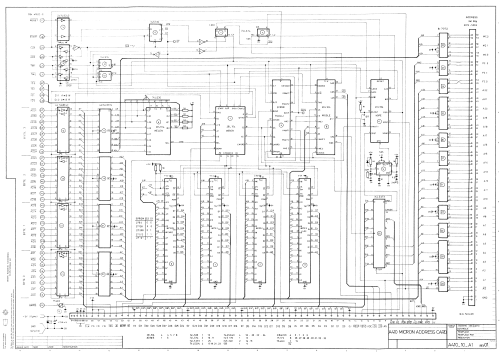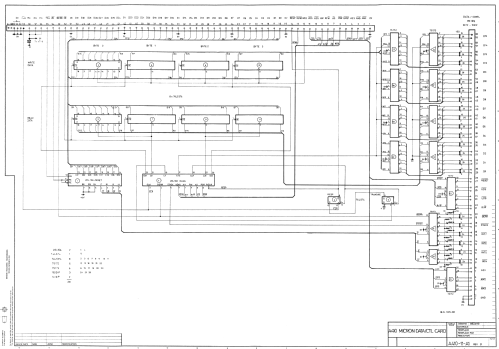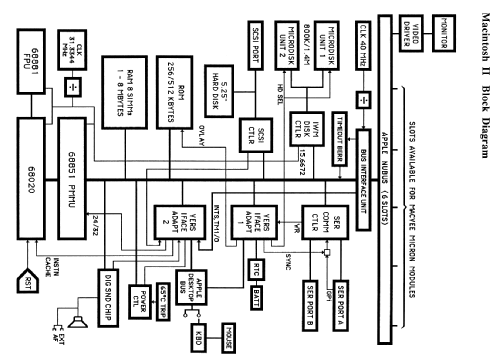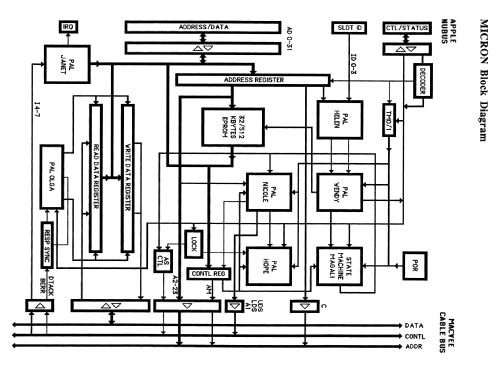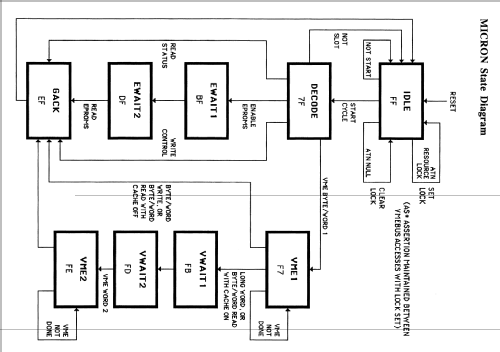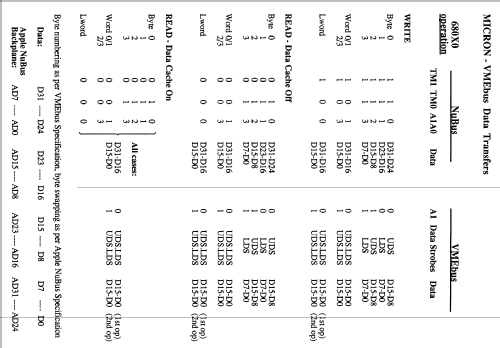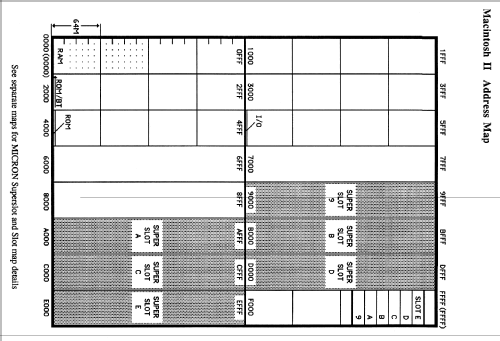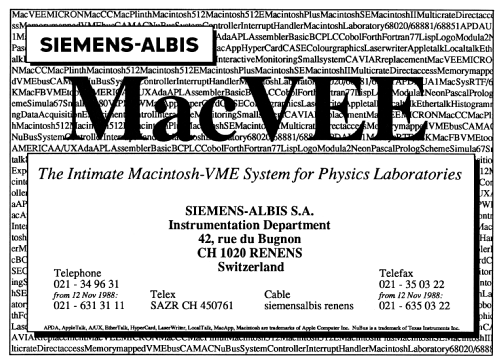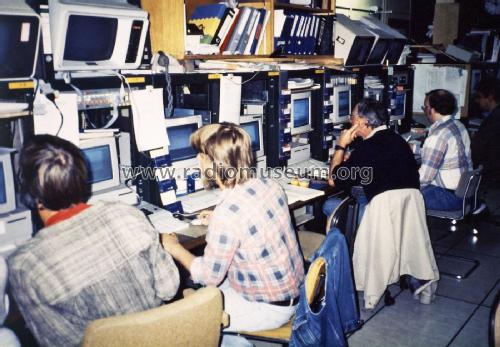- Paese
- Svizzera
- Produttore / Marca
- Albis, Albiswerke AG (Siemens Switzerland AG / Telefunken Zürich AG / Siemens-Albis); Albisrieden
- Anno
- 1987–1993
- Categoria
- Elaborazione di segnali e strumenti di calcolo (Computer e moduli SP)
- Radiomuseum.org ID
- 305082
Clicca sulla miniatura dello schema per richiederlo come documento gratuito.
- Numero di transistor
- Semiconduttori
- PAL20L10A PAL20R8B SN74LS30 SN74LS74 SN74LS273 SN74LS374 SN74AS640 SN74S139 SN74S240 SN75172 SN75173 SN75463 MBM2764 NE555
- Gamme d'onda
- - senza
- Tensioni di funzionamento
- Fornita mediante altra unità o unità principale. / 5 Volt
- Altoparlante
- - - Nessuna uscita audio.
- Materiali
- Printed Circuit Board
- Radiomuseum.org
- Modello: MICRON A410 - Albis, Albiswerke AG Siemens
- Forma
- Chassis o in scatola da montaggio
- Dimensioni (LxAxP)
- 327 x 102 x 20 mm / 12.9 x 4 x 0.8 inch
- Annotazioni
-
MICRON modules allow computers equipped with the IEE 1196-1987 NuBus (such as the 68020-based Macintosh II and the 68030-based Macintosh IIx, IIcx, IIci and IIfx) to access instrumentation in multiple VMEbus and CAMAC crates. The VMEbus or CAMAC crates appear within the address space of the Mac II microprocessor, so that no special software drivers are necessary to access them. Macintosh II family computers with MICRON were still in use in the mid-1990s, until later Power Mac models changed from NuBus to PCI bus.
MICRON supports all data transfer operation types on the Apple NuBus, and automatically performs the required VMEbus operations (e.g., two demultiplexed 16-bit accesses for one longword NuBus operation) so that the interface is transparent to the user. The Macintosh II/NuBus interface performs byte-swapping to match the big-endian byte ordering of the 680x0 processors to the little-endian NuBus byte ordering. This byte-swapping does not affect the order of bits within bytes. All the address non-alignment functionality of the Macintosh II 680x0 is supported through to VMEbus slaves.
Control and status registers are provided on MICRON to allow VMEbus address modifiers to be specified, interrupt sources to be determined, and for mode selection and software reset. The registers are allocated unique addresses outside those used in the computer or external system. Restricted VMEbus resource-locking is implemented through Apple NuBus attention cycles, which are generated automatically when 680x0 RMW instructions are executed.
Data caching, which was introduced in the 68030 architectures, is supported as a programmable option. In data cache mode, MICRON always acquires a 32-bit word from VME for any type of NuBus read. The MICRON state diagram indicates the operations performed by the module for the different Macintosh II/VMEbus data transfer types, on-card EPROM and status read, control register write and attention cycles.
The addressing range of the 680x0-based computers allows a contiguous 128 Mbyte address space to be dedicated to each external system and directly accessed by the microprocessor in 32-bit mode. The address range can be allocated to up to 8 VME crates, or up to 7 VME crates and 8 CAMAC crates, in any mix.
MICRON itself can accommodate up to 512 Kbytes of EPROM in an additional separate address space. The EPROM quad stores 32-bit words and can contain executable code. A small part of this EPROM contains configuration information (Apple's 'declaration data') which is read by the Macintosh slot declaration manager at start-up to determine the characteristics of the hardware present in its slots. The remainder is free for any semi-permanent library extensions, test routines or application programs which the user may wish to store there. Apple assigned MICRON the BoardId $012C.
Each physical NuBus slot in the computer is associated with a Superslot address space of 256 Mbytes and a Slot address space of 16 Mbytes. This association of address allocations with physical slots means that MICRON does not require any jumpers or address configuration switches.
Macintosh II interrupt sources are assigned as follows: Level 1 - VIA1, Level 2 - VIA2, Level 4 - SCC, Level 6 - PwrIRQ, Level 7 - NMI. Devices in any of the six Macintosh II NuBus slots can generate non-master interrupt requests which result in a Level 2 autovectored interrupt to the 680x0 through CA1 of VIA2. The Macintosh II ROM device manager determines the NuBus slot which has generated an interrupt by reading data inputs PA0 - PA5 of VIA2, and maintains an interrupt queue for each slot interrupt. The slot queue element contains a priority parameter which determines the order in which the routines are called and the slots polled.
MICRON was designed by Bruce Taylor and manufactured by Siemens-Albis SA.
- Peso netto
- 0.3 kg / 0 lb 10.6 oz (0.661 lb)
- Autore
- Modello inviato da Bruce Taylor. Utilizzare "Proponi modifica" per inviare ulteriori dati.
- Altri modelli
-
In questo link sono elencati 176 modelli, di cui 152 con immagini e 146 con schemi.
Elenco delle radio e altri apparecchi della Albis, Albiswerke AG (Siemens Switzerland AG / Telefunken Zürich AG / Siemens-Albis); Albisrieden
